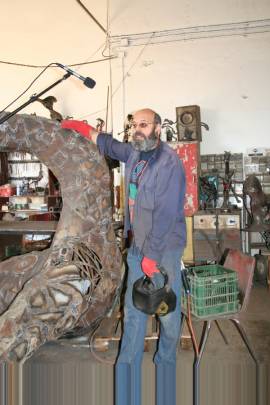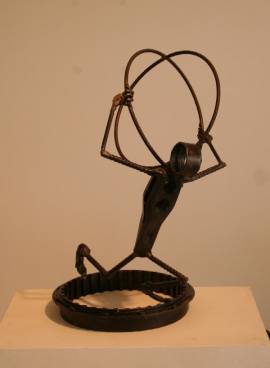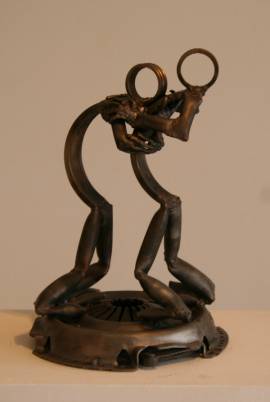The use of random metal objects and their incorporation in a sculpture can be interpreted as a metaphor of the material. The figure built from a collection of objects that originally performed a function, unlike sculptures crafted from a mass of material, has a dynamic effect on the perception of the viewer. One has to imagine the lines connecting and forming the sculpture as a whole. Gonzales refers to this effect: "It remains for the eye to join together this countless number of points in the infinite" In Assemblage Sculpture the artist actually involves the viewer through his imagination in the completion of the image. He uses the visual memory and the cultural background and associations to actively perceive the artwork. The viewer has simultaneously to cope with seeing the image as a whole and the original objects chosen for the artist's indented meaning. The sculptures that Joop creates are born in his imagination by an idea or clue in the material, and are created by joining and combining metal wires, bearings, bolts , springs, gears , wire nets, etc. Joop's work is inspired by everyday life, by regular people, characters from childhood stories or classical literature, by friends and family members. He is able to identify a dominant characteristic of a person and transfer it to the material. His sculptures express humanity and human qualities, portrayed with humor; their faults or failings are depicted with a smile, understanding and empathy. His work is done spontaneously, working directly with the materials, with no detailed drawing, but concentrating on the specific element that expresses the essence of the figure. The expression of the sculpture is achieved by two main elements: the human gesture and the illusion of movement. It seems that there is an intrinsic contradiction between sculpture and movement. The word itself originates from the Latin word static, referring to the sculpture as an object set in space. Throughout history, sculptors have sought ways to impart to their sculptures the sense of movement. An extreme example is kinetic art that includes moving objects bringing actual movement to the statue. But the artist is in fact searching for the illusion of movement. This illusion can be achieved by various means: for example, by composing sequential rhythmical forms, which may create in our minds the sensation of movement by duplication or by repetition of some detail. Another frequently used technique is the use of other complementary objects, such as pieces of cloth or trees, or other backgrounds that imply movement caused by an imaginary wind. The movement is an illusion induced as the eye picks up successive folds. The illusion is generated when the eye sees the movement in the cloth and perceives it as movement of the object in space. Another way to create movement is through a composition that expresses real movement of the human or animal body, like walking, running, or horse jumping. According to Rodin (1840-1917), the sculpture should show the movement as a process, a gesture that shows the completion of one step and the beginning of the following one. The sense of movement may be enhanced by creating a distortion of the anatomical proportions of the figure's organs. Joop's work combines several elements that create the illusion of movement. The advancement of limbs, their emphasized size, the direction of hair blown by an invisible wind, the position or inclination of the head. Although most of the figures are shown in reduction, the movement is prominent. His work exhibits control and mastery of metal handling, cutting, bending, and welding and soldering; the torch in the hands of the iron sculptor is like the brush in the painter's hand. In the process of working he solves technical problems, in design, balancing the figure, positioning and assembling the parts dealing not only with artistic issues but with safety, especially with large-scale sculptures. His techniques have changed and evolved over the years: At first he created works that may be called two dimensions in three dimensions: works made of metal wires or bicycle chains forming an image from lines in space as a drawing in space, tracing the contour of the image. Lately he has produced a new series with this technique. The need to create large-scale projects, avoiding huge mass and heavy weight, led to the development of a special technique: welding of metal sheets like a patch-work to create the surface around a figure built from an iron frame (Giraffe, Woman Lying). Another group of works is built from cut-out iron sheets, joined in parallel, creating an illusion of depth. (Bird) This technique, resembling paper cutouts, may suggest some advance towards the abstract, although Joop perceives his work as figurative. Most sculptures are made by combining several techniques. The universality of Joop De Jong's works is derived from his personal background: born in Holland and educated in European cultural institutions. His studies in these various environments gave him a unique insight and appreciation of the basic values and simplicity of life. Joop is a creative artist in various media: painting, writing and sculpture At the foothills of the Bental mountain, in the communal society, he found inspiration and meaning and the inner peace needed for artistic creation. The exhibition displays a collection of his sculptures, chosen to show his observations of human nature through human gestures. His humorous and sometimes ironic perspective is apparent, together with the optimistic view inherent to his joy of life. Along with the sculptures we present some of his poems, expressing the artist's contemplations on reality, his moods and loneliness. The poems complement the artworks by revealing a more personal context. Poems and artworks from the exhibition to Joop de Jong Site |
 ראשי
ראשי  אודות הגלריה
אודות הגלריה  טל גרינפלד
טל גרינפלד  הדרכות בגלריה
הדרכות בגלריה  קבצים
קבצים  הודעות
הודעות  צור קשר
צור קשר  English
English 

